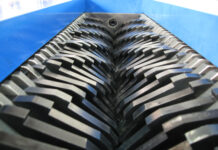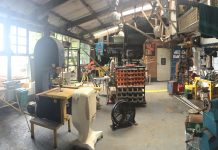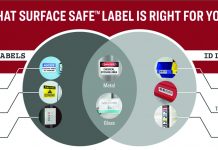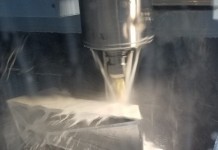
The difference between the optimum robotic torch and an adequate robotic torch could mean the difference between hitting your weekly quality and productivity goals and scrambling to ensure on-time delivery. To help you select the correct torch for your application and to maximize Operational Equipment Efficiency (OEE), quality and profitability you should consider these 10 key points:
Tool Center Point, or TCP, is a point in space with a mathematical reference to the flange of a robot. For robotic GMAW welding, this is essentially how the robot knows where the tip of the wire is. Robots are good at repeating the same motion path time after time. If the tip of the wire changes due to thermal or physical distortion, the weld placement will change. In severe cases, the torch will crash into the part or weld fixture.
A change of the TCP over time means that the robot will deposit the weld bead somewhere other than the center of the joint. When this happens, operators may compensate for TCP drift by increasing bead width, such as by slowing travel speed or programming a slight weave into the torch movement, to ensure that the weld encompasses both plates and provides sufficient fusion. Unfortunately as a result of an incorrect TCP, larger-than-necessary weld beads increase filler metal and gas costs, cycle time, heat input and total weld cost. In short, compensation kills profitability in automated welding and it may compromise mechanical properties as well. Selecting a robotic torch with a consistent TCP can be the first step in welding improvement and reducing filler metal consumption.
TCP is, by far, the most important attribute to consider when evaluating robotic torches. To ensure a consistent and repeatable TCP, look for robust necks and mounting systems. For example, ESAB machines the clamping flange of its Aristo® RT robotic torches from a solid piece of stainless steel. These necks have a wall thickness about three times that of a typical competitor’s product and, as a result, can withstand a collision and still maintain TCP. Further, they hold dimensional tolerances over time. They’re so robust that TCP alignment tools aren’t needed (and, in fact, can’t even bend the neck). Comparatively, less robust necks require TCP neck alignment after a certain number of heating and cooling cycles, and a much-needed alignment may not coincide with scheduled maintenance causing the OEE to reduce. In addition, the Aristo® RT Torch doesn’t need to have the TCP recalibrated when changing the consumables or the same angle swan neck, minimizing downtime.
While a 22-degree mount with a 22-degree torch basically offers the same amount of bend as a 0-degree mount with a 45-degree neck, the latter combination works better for welding small circles, such as around an axle. With a 45-degree neck, the torch can spin around the 6th axis of the robot (where the torch mounts to the robot arm) in smaller circles. Conversely, a 0-degree mount with a 22-degree neck works well when you need to reach into a small opening.
If you have one application best suited for a 45-degree neck and another application where a 22-degree neck works better, select an Aristo torch bundle with a modular design. This lets you change the neck off the torch bundle (without tools) and insert the neck best suited for the application. For job shops, this modular approach adds flexibility and reduces changeover time between parts.
The answer depends on how many points require programming and the amount of air movement time. The external cables of a conventional torch limit arm rotation to +/- 240 degrees. After making a circular weld, the next point in the program brings the torch to a safe space and unwinds the cable. With an infinitely turning media coupling of an Aristo RT Infiniturn torch, the arm can move directly to the next weld. Infiniturn torches reduce programming time, as well as reduce unproductive air time. For parts with many circular welds, an Infiniturn torch will reduce per-piece costs compared to a conventional torch. As an added advantage, locating the media coupling inside the robot arm protects it from damage, as well as extends the life of the cable.
Before part production begins, take a 3D model of your part and test it in virtual reality. This will ensure correct torch selection prior to purchase.
Conventional mechanical reamers clamp the torch nozzle, which may deform the nozzle and distort gas flow and affect TCP. Second, the reamer wears the consumables faster, and the process of mechanically scraping the nozzle and contact tip may have TCP implications. Third, reamers cannot remove spatter from the gas baffle, potentially leading to gas flow interruptions and inconsistent weld quality.
Conversely, the JetStream RT particle jet torch cleaning station cleans consumables with a high velocity blast of aluminum oxide particles. It cleans all torch components (nozzle, tip, gas baffle) and does so without mechanically gripping the torch. As a result, the JetStream extends consumables life, preserves TCP and maximizes OEE.
With threaded nozzles, the threads become loose due to thermal changes in the constant heating and cooling cycles. A compression-fit nozzle slides over the end of the torch. It, too, becomes loose over time with repeated removal and thermal changes, and a fast air move could possibly throw the nozzle. The ESAB Aristo RT series combines both threaded and compression-fit technologies. This enables the compression fitting to hold the nozzle in place, even as the torch heats up and the threads loosen.
An integrated blow out line is a second gas line (the first being the shielding line) that connects to the shop air supply. During air movement time, the blow out line enables using basically free shop air to cool the torch instead of expensive shielding gas. This can lengthen consumable life and improve TCP stability.
When analyzing consumables, you need to consider both the cost of downtime (OEE) and consumable cost difference. In most cases, the downtime costs are significantly higher than the cost of premium consumables. ESAB recommends that you use their CuCrCz Copper Chrome Zirconium long lasting contact tip and consumables, as they will help prevent unplanned downtime and lower the weld cost.
Frequent arm rotation combined with the heat of the weld puts constant pressure on automated MIG gun liners. To make the changing of the liner easier the Aristo RT torch has been designed with a separate neck liner meaning that the changeover time is minimized.














